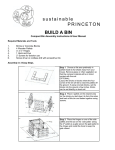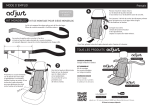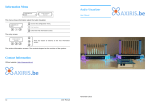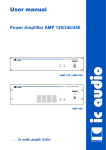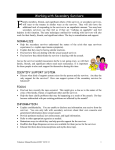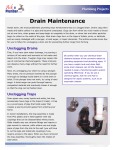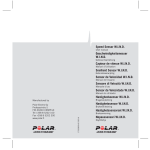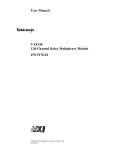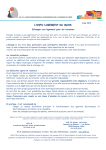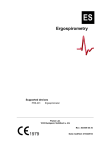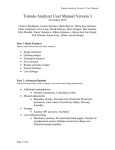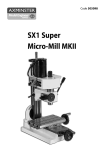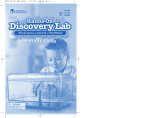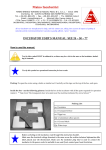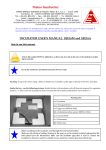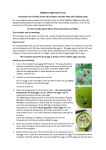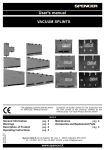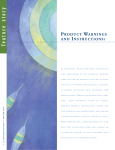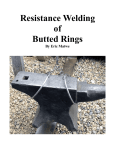Download 1 purpose of this document
Transcript
® SEeMAx version NT Evolution / MO 1.40 octobre 2002 EXTRACT ______________________________________ le Rolland de TRAMOLE 38300 BOURGOIN-JALLIEU FRANCE Tél. : (33) 4 74 27 94 08 Fax. : (33) 4 74 27 94 31 www.sd2b.com 1 PURPOSE OF THIS DOCUMENT ® This is an extract of the user manual of the SEeMAx automatic egg candling system, version «Evolution». 2 INTRODUCTION 2.1 PURPOSE OF THE INSPECTION ® ® The purpose of the SEeMAx system is to automatically candle eggs. SEeMAx inspects the exterior appearance of eggshells on the packing lines, and rejects those eggs that show blemishes rendering them unsuitable for preservation or commercialization. 2.2 PRINCIPLES OF OPERATION ® SEeMAx is a high-performance artificial vision system, which automatically candles eggs. The inspection takes place with the assistance of an artificial vision system using a matrix of CCD camera’s and two LED light sources: 1. lighting from above through large diffusing panels, 2. lighting from below each egg, inspecting by transparency as on traditional candling tables. Lights are activated in alternating sequence: first from below, then from above. Normally off, the lights flash on only during the scan. Subsequent to the inspection, a grade is assigned to each egg. ® The connection to the calibrating and packing machine is brand specific. SEeMAx can, by way of a TOR link (All or Nothing, 1 or 0) , make the decision to: ⇒ keep the egg, ⇒ reject it as «Bad», ⇒ reject it as «Very bad». A grade is assigned by analyzing the size and shape of imperfections detected on the egg. The criteria of size and shape are adjustable parameters set by the operator. In addition, the system verifies the color or hue of each egg. This is accomplished by comparing the value of each egg’s gray-scale image against that of the current production run. These parameters are adjustable by the operator. Each egg is checked six times: three successive steps followed by three intermediary half steps. Rotating the egg 1/6 of its circumference between scans allows practically the whole surface to be inspected. Three cameras are used for a six-row packing line. User Manual page 1 The fields are defined as follows: 6-ROW CONVEYOR VIEW FROM ABOVE Row 6 Camera 3 Row 5 Row 4 Conveyor direction Camera 2 Row 3 Row 2 Camera 1 Row 1 ® SEeMAx acquires four images per displacement of the eggs on the conveyor belt: - Two images at each exact « even » position, with illumination from above and below, - Two images between each « odd » position with illumination from above and below. One camera scans two consecutive rows on the conveyor belt, three eggs per row. Therefore, on a conveyor belt with six rows, 4 x 3 images of 2 x 3 eggs each are taken. Camera installation on such a conveyor belt is as follows: The field of vision of a camera is 185mm x 210mm. The base resolution of an element of an image (pixel) is 0.3mm x 0.4mm. User Manual page 2 2.3 INSPECTION ZONE ® SEeMAx inspects each egg six times, the egg rotating 1/6 revolution between each take, thus allowing practically the whole surface of the egg to be checked. Yet, two zones remain veiled: the inferior and superior poles of the egg, which are not seen. 2.4 EGG REJECTION ALGORITHMS ® SEeMAx uses six rejection algorithms: ⇒ Color ⇒ Shape ⇒ Cracks ⇒ Stains ⇒ Spots and holes Each algorithm uses specific detection criteria: • For color detection, the gray-scale image of the egg is used; • For shape detection, a comparative ratio between the existing shape of the egg with that of a theoretical ideal ovoid shape that would fit in the rectangle framing the egg ; • For crack detection, the cumulative length of all cracks on the eggs’ surface ; • For stain detection, the cumulative surface area of all defects ; • For spot and hole detection, the surface area of the largest fault on the shell. Parameters for each algorithm are set using two reference levels: • A lower limit, • An upper limit. The only parameters that cannot be set are those for shape detection. Each algorithm produces a result either in the form of a grade from 0 to 10, or based on a level of rejection. Results are determined as follows: • Criteria < Lower limit: ⇒ egg «accepted», ⇒ grade = 10. • Lower limit < Criteria < Upper limit: ⇒ Egg rejected as «bad», ⇒ grade = 10 x (Criteria – Lower limit) / (Upper limit – Lower limit). • Lower limit > Upper limit: ⇒ Egg rejected as «very bad», ⇒ grade = 0. The overall score of an egg is based on the various results obtained from each detection algorithm. User Manual page 3 2.5 OPERATING BASICS ® The basic operating cycle of SEeMAx is as follows: • Await the advance of the conveyor. • Simultaneous image acquisition of the eggs by the three camera’s from above, indicating forward movement by the conveyor (« SCAN »…) • Each camera in sequence then: • pre-processes the image, • measures the gray-scale level of each egg, • searches for all faults present on each egg, • analyzes the contour of each egg. • Compare each criterion against the reference limits. If levels are equal, rejection priority is as follows : ⇒ Color, ⇒ Shape. ⇒ Cracks, ⇒ Stains, ⇒ Spots/Holes, • Store the results of the inspection of each egg in the lower memory buffer of a bank of registers. The register size can be selected. • Upon receipt of the «Set result» signal, update «Results of row 1» into «Results of row n», based on the results in the upper register. Upon receipt of the «Reset results» signal, reset the exit «Results of row i» and shift to the top of the register. • 2.6 PRODUCTION FOLLOW-UP ® SEeMAx tallies the eggs that were accepted, as well as those that were rejected as «bad» and «very bad». ® SEeMAx compiles statistics to gauge the number of rejected «Bad’s» (grade from 0 to 10) and «Very bad’s» (grade equal to zero) for each detection algorithm. This significantly facilitates finetuning of the various adjustable parameter settings associated with each algorithm. Warning: these statistics provide but a general picture of the distribution of the types of defects. This ® is due to possible confusion between the types of defects (see 2.9). SEeMAx does not sort by specific type of defect, but instead carries out a comprehensive visual inspection. User Manual page 4 2.7 QUALITY FACTORS ® SEeMAx has several sets of adjustable parameter settings, which make it possible to choose the ® degree of rejection severity or «Quality Factor» implemented by SEeMAx . The quality levels (their names and corresponding settings) are defined by the operator. 2.8 NATURE OF THE BATCHES OF EGGS Eggs do not always resemble each other. Large classes exist: • «brown» or «red» eggs, • «white» eggs, • spotted eggs (farm-type). ® These various batches require appreciably different processing parameters. SEeMAx has several sets of pre-programmed parameters making it possible to adapt to each batch of egg. For «white» eggs, for example, the control of egg hue (paleness) would be inhibited. 2.9 CLASSIFICATION OF DEFECTS 2.9.1 Spots and stains Several types of spots or stains are present on eggshells: • Blood • Yolk • Egg white • Excrement: solid or liquid • Dust deposits • Foreign bodies stuck to the shell: straw, feathers, … • Egg crystallization defects • Pigmentation defects • Calcification defects • Localized calcium agglomerations SEeMAx® does not see narrow stains of fresh egg white, or colorless stains of liquid excrement. ® SEeMAx does not distinguish between various stains. All visible defects on the shell are treated the same way. The system decides to reject or accept a stained or dirty egg based on the following two criteria: • The surface area of each defect found on the shell, • The cumulative surface area of all defects found on the shell. The localized defects of pigmentation, calcification and of crystallization are imperfections which can cause the rejection of an egg according to their respective surfaces areas. User Manual page 5 2.9.2 Holes A hole is characterized as an absence of shell. ® SEeMAx does not differentiate between holes and stains. Holes are seen by the system as stains and are dealt with using the same algorithm. An egg containing just a small round hole (very small surface area), will not be rejected. 2.9.3 Network of micro-cracks A network of micro-cracks is a tangle of dense, microscopic fissures, somewhat long, having the appearance of dark stains. The network of micro-cracks is detected with the same algorithm used to find stains. 2.9.4 Cracks A crack is a more or less marked fracture of the shell. ® SEeMAx detects the presence of open cracks, i.e. those with two disjoined edges. The system decides to accept or reject a cracked egg based on the following criteria: • The total cumulative length of all visible cracks on the egg. 2.9.5 Caved-in Shell A caved-in shell is a localized depression on the eggshell. This defect is characterized by a network of fissures in the shape of a spider web, and is often accompanied by a hole in the center of the depression. This type of defect is detected either by the algorithm to detect stains, when a central hole exists, or by the method of detecting cracks. 2.9.6 Shape The algorithm to check the shape of an egg verifies the contour of each egg. The purpose of this inspection is to eliminate eggs that are completely caved-in, and those broken in two. Severely messed-up eggs are also eliminated using this algorithm. Detecting shape defects necessitates an excellent contrast between the egg and the rollers (i.e. impossible on yellow or gray rollers). 2.9.7 Color Color defects derive from a lack of general pigmentation of the shell. SEeMAx inspection by utilizing the general gray-scale image of a shell. ® realizes color Eggs that are too clear are rejected on the basis of the following criteria: • A Gray-scale level of the egg that exceeds (is clearer than) the percentage of the average production. The average production is based on the last 1000 eggs processed. User Manual page 6 2.9.8 Defects not taken in account ® Any defect that is not a blemish is not taken into account. In particular, SEeMAx does not check: • Soft eggs, • Fragile eggs, • Micro-fissures, • The size of the eggs’ air cell, • Blood spots inside the eggs. User Manual page 7 3 DESCRIPTION OF THE SYSTEM 3.1 Architecture SEeMAx 6 rows Video connect Lighting feed & control SEeMAx 8122 IMAGING CASE Conveyor Elec. Feed 220V~ Mono Synchronization signals Results, RS232 or TOR ResetAuto Manuel Powered Up Electrical Equipment Box of the Packing Line Data Processing Bay User Manual page 8 3.2 IMAGING CASE The imaging case is installed directly on the packing line. IMAGING CASE Video cable Power supply Access panel to camera’s Ventilated filter (one on each side) Power Light Power switch «Main» Access panel to upper lights (one on each side) SEeMAx Access panel to interior of case Lighting From below Overall dimensions for 6 rows: height: 700mm, length 715mm (dimensions likely to vary according to installation on the grading machine). Length doubled for 12 rows. The case occupies the whole width of the conveyor. The case is made up of two parts: • • A camera enclosure (upper part), which contains: ⇒ the matrix of camera’s, ⇒ a camera multiplexor, ⇒ an electronic platen, ⇒ two ventilators. A lighting enclosure (lower part), which contains: ⇒ two high intensity red LED panels and diffusing plates. Positioned below the imaging case, under the conveyor: • lights from below, composed of molded LED’s arranged beneath each egg position where the inspection is carried out (step, and half step). User Manual page 9 3.3 DATA PROCESSING BAY The data processing bay contains: • A PENTIUM PC based computer, operating under Windows NT, equipped with a MATROX METEOR image acquisition card that carries out the candling functions. There is one such computer for each 6-row segment. • One PC type computer using the Linux operating system, that provides the interface to the grading and packing machine. • An electronic platen. DATA PROCESSING BAY Luminous Glass Casing Red and green Control Screen Main Power Switch Sous Tension Auto/Man. Operation Access to PC for Auto Data Management Manuel Keyboard Access to PC for Candling Operations Access to the Electronic Platen Overall dimensions: • Height: 2000mm ( add 240mm for the Glass Casing). • Width: 600mm. Depth: 600mm. User Manual page 10











